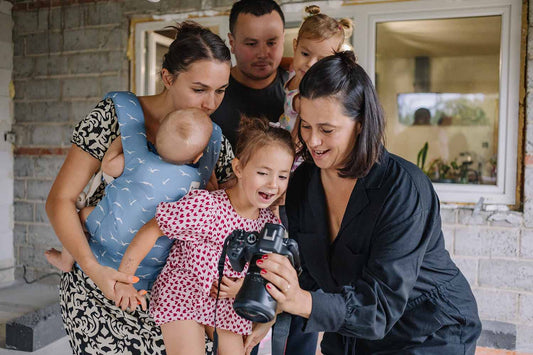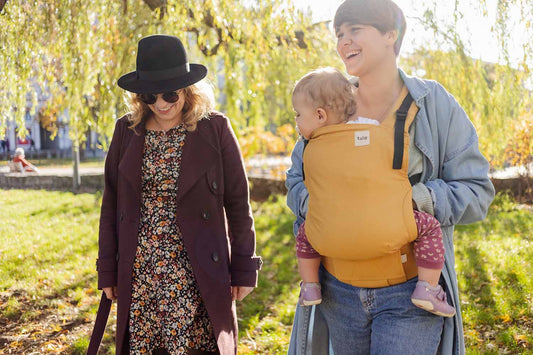How babywearing nurtures your baby's development for a lifetime. Backed by science.
Carrying your baby using a sling, wrap, or carrier, offers a multitude of benefits for both you and your little one. Backed by scientific research[1][2], this age-old tradition has evolved into a valuable tool that aids in physical, emotional, and social development.
Using baby carriers to wear your baby is an ancestral tradition in nearly every civilization worldwide. Many cultures have an unbroken tradition of using carriers, but others, (like the US) are reacquainting themselves with the benefits for both baby and caregiver. One science article says that carrying human infants is “an evolutionary heritage” and they believe “that the emphasis should be on the fact that carrying is the biological norm rather than claiming additional advantages of carrying." However, for the sake of our blog, we’ll dive into the benefits too 😉
Let's explore how this practice positively impacts both you and your baby.
Kangaroo Care: A Foundation for Babywearing Benefits
 Originating as a revolutionary method to care for preterm and low birth weight infants, kangaroo care involves skin-to-skin contact between the caregiver and the baby. By utilizing an adult's body as a natural incubator, this practice has proven effective in preventing neonatal mortality in high-risk communities[3]. With the help of a woven or stretchy fabric, kangaroo care harnesses the power of physical closeness to regulate the fragile physiology of newborns, promoting weight gain and improved overall health. Read more about Kangaroo Care.
Originating as a revolutionary method to care for preterm and low birth weight infants, kangaroo care involves skin-to-skin contact between the caregiver and the baby. By utilizing an adult's body as a natural incubator, this practice has proven effective in preventing neonatal mortality in high-risk communities[3]. With the help of a woven or stretchy fabric, kangaroo care harnesses the power of physical closeness to regulate the fragile physiology of newborns, promoting weight gain and improved overall health. Read more about Kangaroo Care.
Physical Development: From Balance to Spine Health
Babywearing serves as an exercise for your baby's vestibular system, enhancing balance and motor development. Dr. Bill and Martha Sears emphasize that babywearing contributes to better breathing, growth regulation, and improved motor skills. Moreover, it fosters visual and auditory alertness, optimizing various physiological systems[4]. Carrying your baby in the ergonomic M-shape formation supports proper spine development, aiding in a balanced transition from crawling to walking. Read more...
Plagiocephaly (Flat Head) Prevention and Supportive Carriers
A baby worn upright or in various positions experiences reduced risk of plagiocephaly, a condition where portions of the baby's head flatten. By minimizing time spent on their backs, babywearing plays a pivotal role in preventing this cosmetic issue and the potential neurological concerns it may lead to. Properly designed carriers further support spine health by distributing weight through the hips and legs, relieving pressure on the baby's developing spine and hips.
Emotional and Social Development: Bonding and Happiness for Parent and Child
Babywearing contributes to improved bonding and emotional connections between you and your baby. The concept of kangaroo care demonstrates how this practice facilitates positive physical, social, and emotional development. Kangaroo care studies have shown reduced distress during painful procedures, earlier social awareness, and enhanced breastfeeding success for mothers to name just a few. In one study, the use of baby carriers was shown to increase breastfeeding duration among term infants: "While breastfeeding rates were similar in both intervention and control groups at discharge from the maternity ward, mothers in the intervention group scored significantly higher with their infants at two (72% vs 51%) and at 5 months of age (48% vs 24%), respectively." Additionally, participating in kangaroo care has been linked to decreased postpartum depression[5][6][7].
Wearing Babies in a Baby Carrier Improves Breastfeeding Success
Engaging in extended physical contact could be a possible solution for increasing breastfeeding success as evidenced by a recent controlled research study, which sought to investigate baby carriers as a potential and easily accessible tool to increase breastfeeding duration in normal, low-risk mothers.
The study supports that many individually reported experiences of improved breastfeeding outcomes from using a baby carrier, even in the face of non-optimum birth and postnatal care. Read more...
Learn How to Breastfeed in Your Tula Baby Carrier
Babywearing Beyond Kangaroo Care: Crying Reduction

Wearing your baby in a baby carrier holds the potential to decrease infant crying, offering solace to both the baby and caregiver. Research indicates that increased physical contact with caregivers leads to reduced crying in infants[8]. The impact extends from simple skin-to-skin contact to wearing your baby in a carrier. Studies have revealed that babies carried in motion show enhanced calming responses and relaxation, further endorsing the positive effects of babywearing[9]. Read more....
How does physical contact regulate infant distress?
Biological Mechanisms: Sensory Stimulation
In an experimental study with mouse pups, experimenters isolated the effects of physical contact from related sensations of maternal carrying. Experimenters administered local anesthesia to the part of the body in physical contact with the mother during carrying (i.e., the base of the neck where the mouse mother picks up the pup), thereby removing the effect of physical contact. When mouse pups couldn’t actually feel the sensation of tactile contact from the mother, the calming reaction – that mouse pups usually show when carried – was not demonstrated. Similarly, after temporarily disrupting the functioning of the part of the brain that controls proprioception, which allows us to feel rhythmic sensations like being rocked, being carried by the mothers also did not elicit the calming effect seen in mouse pups during normal carrying interactions. When exposing the mouse pups to visual, olfactory, or auditory stimuli, the calming effects also could not be induced. These results show that both the physical contact with the mother and the sensation of being rocked are responsible for the calming effects of carrying.
Why is touch and physical contact more calming than visual or vocal contact with caregivers?
Many people know that newborns do not arrive into the world with fully-developed eyesight and in fact, both the visual and auditory systems are still developing well into the first years of life. Given the sensitivity of the developing sensory system, inappropriate amounts of visual or auditory stimulation not only lack the ability to calm infants, but can actually interrupt sensory development and physiological processes like sleep cycles. Physical contact is the most gentle and developmentally-appropriate modality of interaction with newborn infants. In addition, babywearing in a front carrier (not forward-facing) allows infants to regulate their stimulation level by giving them a place to turn their face into the calming safety zone of the caregiver’s chest, rather than being bombarded with overwhelming amounts of visual and auditory stimulation.
Biological Mechanisms: Oxytocin
It is nearly impossible to read anything about birthing and postnatal bonding without mention of the “love drug” oxytocin. Within the context of infant-caregiver physical contact, the production of the neuropeptide oxytocin that is stimulated by skin-to-skin contact is able to increase maternal breast temperature, explaining the miraculous incubator-like effects of skin-to-skin kangaroo care (for more info, see the blog post on kangaroo care). Beyond the physiological effects, can oxytocin also provide an explanation for increased calmness and decreased crying associated with babywearing?
It is unclear whether oxytocin itself decreases crying. However, oxytocin may be mediating decreased crying through a social mechanism: increased maternal responsiveness. Oxytocin is well established in its ability to elicit maternal care and affection and has also been shown to increase patience and interactivity in fathers. Oxytocin is also specifically implicated in the neural response to infant crying.
So why would maternal responsiveness explain the calming effects of babywearing?
 Social Mechanisms: Responsiveness
Social Mechanisms: Responsiveness
Responsiveness refers to the ability to respond to infants’ signals promptly and appropriately. Why is this important when trying to understand the relationship between physical contact and crying?
As outlined in a previous blog on crying and physical contact, the cultures with the lowest rates of crying have some of the highest rates of physical contact with infants. Interestingly, these proximal care cultures also exhibit another important difference in care-giving style: increased responsiveness. Specifically, adult caregivers respond more quickly – almost in an anticipatory fashion – to infants’ cues. In contrast to Western culture, responsiveness in these cultures often refers to a tendency to respond specifically to signs of distress, rather than playful bids for attention.
Experimental research has also highlighted a connection between babywearing, responsiveness, and decreased crying. In the intervention study of the effect of babywearing by Anisfeld and colleagues, mothers in the babywearing group were more responsive to infants during a play session at three months than parents in the control group. Developmental scientists – in studies such as these – generally measure responsiveness as vocal or visual communicative responses within the context of dyadic playtime between infants and caregivers. But a closer look at the variation in responsiveness across cultures suggests that this methodological approach may be constraining our views of responsiveness. In proximal care cultures, responsiveness is not only referring to highly contingent responses to any sign of infant distress, but to a specific type of response, which is often offering the breast for nursing.
Cultural Insights and Global Impact
Cultural practices that prioritize proximal caregiving, including babywearing, have been associated with lower levels of infant distress. In non-Western societies, infants often experience increased physical contact and decreased crying. The benefits of skin-to-skin contact extend globally, with studies indicating that kangaroo care and babywearing have positive effects on infant behavior and caregiver well-being [10][11].
Give baby carriers a try!
The consensus is clear: the benefits of skin-to-skin contact have been consistently proven with the highest standard of scientific research. Many of these same benefits likely extend to standard babywearing without direct skin-to-skin contact, but the overwhelming amount of data confirming the positive effects of skin-to-skin carrying may tempt you to give kangaroo care a try. So where to start?
The optimal positioning for post-natal skin-to-skin kangaroo care is with the baby placed upright on the caregiver’s naked chest with baby wearing only a diaper. Baby’s head should be turned and slightly tilted upright to ensure the airway remains open and unblocked (and visible!). Baby’s knees should be bent and legs open so that an M-shape is formed with baby’s feet, knees, and bottom.
Once in the proper position, the baby can be secured in place with a carrier, such that the fabric of the carrier is tight enough around the chest of the baby to keep them snug and secure, yet loose enough around baby’s abdomen to ensure that breathing is not inhibited.
Though traditional kangaroo care suggests securing your kangaroo baby with a simple woven or stretchy wrap, skin-to-skin carrying can be done with any of your favorite Tula carriers, including Baby Tula Ring Slings, and our Soft Structured Carriers.
Kangaroo care benefits are not specific to mothers nor to women, so let baby’s other caregivers enjoy skin-to-skin carrying as well!

From fostering physical development to nurturing emotional bonds, wearing your little ones in a baby carrier emerges as a versatile practice backed by extensive scientific research. Whether inspired by kangaroo care or the desire to reduce crying, babywearing offers a multitude of benefits that transcend cultural boundaries. By choosing comfortable, ergonomic carriers and practicing safe positioning, you can embark on a journey of discovery and connection with your little one, supported by the rich tapestry of babywearing science.
Additional Resources and Research:
To have and to hold: Effects of physical contact on infants and their caregivers
What Is the Experience of Babywearing a NICU Graduate?
Culture, Carrying, and Communication: Beliefs and Behavior Associated with Babywearing
A soft baby carrier intervention enhances amygdala responses to infant crying in fathers.
Increased Carrying Reduces Infant Crying: A Randomized Controlled Trial
Positive Effects of Carrying Your Baby
Positive Effects of Carrying for Society
Positive Effects of Carrying for Parents and Caregivers
Babywearing: 23 Science-Backed Benefits
Note: When using kangaroo care as a medical treatment to care for a low birth weight or preterm infant, please seek professional medical advice. The information provided here is meant as a guide for healthy typically-developing infants only, and it is still recommended that you seek professional guidance from a babywearing educator –especially when wrapping newborns – to ensure that your baby is wrapped safely.
Resources:
[^1^]: Moore, E. R., Anderson, G. C., & Bergman, N. (2007). Early skin-to-skin contact for mothers and their healthy newborn infants (Review). Cochrane database of systematic Reviews, 3, 1-63.
[^2^]: St James-Roberts, I., Alvarez, M., Csipke, E., Abramsky, T., Goodwin, J., & Sorgenfrei, E. (2006). Infant crying and sleeping in London, Copenhagen and when parents adopt a “proximal” form of care. Pediatrics, 117(6), e1146-e1155.
[^3^]: Ferber, S. G., & Makhoul, I. R. (2004). The Effect of Skin-to-Skin Contact (Kangaroo Care) Shortly After Birth on the Neurobehavioral Responses of the Term Newborn: A Randomized, Controlled Trial. PEDIATRICS, 113(4), 858-865.
[^4^]: Christensson, K., Siles, C., Moreno, L., Belaustequi, A., De La Fuente, P., Lagercrantz, H., … Winberg, J. (1992). Temperature, metabolic adaptation and crying in healthy full-term newborns cared for skin-to-skin or in a cot. Acta Paediatrica, 81(6-7), 488-493.
[^5^]: Bier, J. B. (1996). Comparison of Skin-to-Skin Contact With Standard Contact in Low-Birth-Weight Infants Who Are Breast-Fed. Arch Pediatr Adolesc Med, 150(12), 1265.
[^6^]: Tessier, R., Cristo, M., Velez, S., Giron, M., Ruiz-Palaez, J. G., Charpak, Y., & Charpak, N. (1998). Kangaroo Mother Care and the Bonding Hypothesis. PEDIATRICS, 102(2), e17-e17.
[^7^]: De Alencar, A. E., Arraes, L. C., De Albuquerque, E. C., & Alves, J. G. (2007). Effect of Kangaroo Mother Care on Postpartum Depression. Journal of Tropical Pediatrics, 55(1), 36-38.
[^8^]: Hunziker, U. A., & Barr, R. G. (1986). Increased carrying reduces infant crying: a randomized controlled trial. Pediatrics, 77(5), 641-648.
[^9^]: Esposito, G., Yoshida, S., Ohnishi, R., Tsuneoka, Y., del Carmen Rostagno, M., Yokota, S., … & Venuti, P. (2013). Infant calming responses during maternal carrying in humans and mice. Current Biology, 23(9), 739-745.
[^10^]: Hewlett, B. S., Lamb, M. E., Shannon, D., Leyendecker, B., & Schölmerich, A. (1998). Culture and early infancy among central African foragers and farmers.Developmental Psychology, 34(4), 653.
[^11^]: Barr, R. G., Konner, M., Bakeman, R., & Adamson, L. (1991). C






